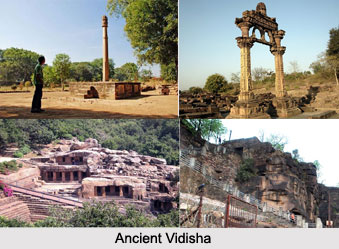 Vidisha is a city in the state of Madhya Pradesh. This place is historically notified for the archaeological places, temples and caves.
Vidisha is a city in the state of Madhya Pradesh. This place is historically notified for the archaeological places, temples and caves.
Location of Vidisha
Vidisha is located near the capital city of Madhya Pradesh-Bhopal. Vidisha is the administrative headquarters of Vidisha District. The city was also known as Bhelsa during the medieval period.
History of Vidisha
The town of Besnagar, 3 km from present-day Vidisha on the west side of the river, became an important trade centre in the 6th and 5th centuries BC, under the Shunga Dynasty, Naga Dynasty , Satavahana Dynasty, and Gupta Empire, and was mentioned in the Pali language scriptures. The Emperor Ashoka was the governor of Vidisha during his father`s lifetime. His Buddhist Empress Vidisha Devi who was also his first wife was brought up in Vidisha. Lord Rama in Ramayana is believed to have come here. His foot impressions are still there which were kept safe by the people and are now properly constructed. They are popularly known as "Charan Teerth" at one of the ghats of river Betwa.
Geography of Vidisha
Vidisha is located at 23.53 degree North to 77.82 degree East. It has an average elevation of 424 metres (1391 feet). The town is situated east of the Betwa River, in the fork of the Betwa and Bes rivers, 9 km from Sanchi.
Population of Vidisha
According to the Population Census in the year 2011, Vidisha had a population of 155,959. Males constitute 53.21% of the population and females 46.79%.
Education of Vidisha
Vidisha has an average literacy rate of 86.88%, higher than the national average of 74.04%: male literacy is 92.29%, and female literacy is 80.98%. In Vidisha, 15% of the population is under 6 years of age.
Tourism in Vidisha
Vidisha has many temples and archaeological places and caves. This city is noted for the Buddhism and Jainism in Central India. Near the eastern edge of the old town of Vidisha are the remains of a large temple of the late Paramara period known as the Bijamandal. The building was probably started in the second half of the 11th century. That it was never finished is shown by carved niches and unfinished architectural pieces found around the base of the temple plinth. On top of the plinth is a small mosque made using pillars, one of which has an inscription dating probably from the time of king Naravarman (circa 1094-1134). It is a devotional inscription revering Carccika or Chamunda, of whom he was a devotee. The minar suggests the mosque was constructed in the late 14th century. To one side of the Bijamandal is a store house of the Archaeological Survey of India containing many sculptures collected in the neighbourhood. A step-well of the 7th century is in the same campus and has, beside the entrance, two tall pillars with the bathing tales of Lord Krishna.
Visiting Information
Vidisha is a railway station on the Delhi-Chennai, Delhi-Mumbai main line of the Central Railway, at a distance of 54 km from Bhopal, the capital of Madhya Pradesh. Sanchi on the Jhansi-Itarsi section of the West Central Railway, and Vidisha that is only 9 km from Sanchi is the more convenient way.



















